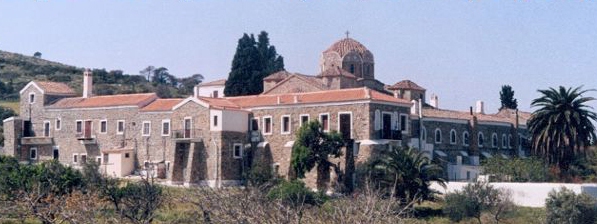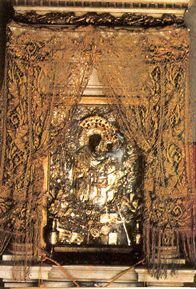
The holy Phaneromene monastery on Salamis is located at the north side of the island opposite to Nea Peramos, Megara. It was established in the 17th century from Lampros Canellos, later on Saint Laurentios.
This pious christian and inhabitant of Megara saw Panagia in a vision who commanded him to go to the place she indicated, in order to build her church.
In the beginning he hesitated to obey and it was necessary for Panagia to appear for a second and a third time to him. Finally, he came to the beach, in 1640, in order to pass opposite to Salamis. But the sea was so rough and there was no boat around there, so it seemed impossible to pass across. As he was sitting and thinking, he heard an unworldly voice voice saying: <Throw your cape on the sea and sitting on it it will guide you to the island in safety>. Expelling every fear, he passed the sea on his cape and reached at Salamina. Digging in the ruins of an older monastery of the 13th century, at the place indicated by Panagia, he found her miraculous icon, blackened by humidity, but a real treasure for the island and for Orthodoxy.

The icon of the Theotokos was named Phaneromene, which means revealed, because it was indeed revealed to the Saint. The monastery was reconstructed by the saint in 1682 a.c, and received the same name, too. The saint became a monk and then a charismatic abbot with the name Laurentios.
During the Revolution of 1821, the monastery of Faneromeni constituted a hospital for the fighters and a sanctuary for the civilians. There were days when 75.000 people were fed there. The numerous animals were sacrificed for the needs of maintenance. The forest of the monastery was cut for sheltering and heating. But, there were days that there was no flour left to make a holy bread. The legendary abbot of the monastery Gregorios was an active member of the Filiki Eteria.
In this monastery fighters such as Makriyannis, Tzavelas, Ypsilantis, Karaiskakis and many more were hosted and held meetings and attributed their rescue to Panagia. Kütahı, attempted repeatedly to occupy the monastery without success. In the monastery yard lies the grave of captain Ioannis Gouras Also, the library and the printing shop of Athens were hosted here. In the entrance of the monastery, in the side of the sea, lies the residence where poet Angelos Sikelianos lived.
In the 20th century it started to decline. But in 1944, the metropolitan Iakovos transformed the monastery to female and installed a brotherhood, giving life to it. Today the nuns are 18.
The monastery is dedicated to the Assumption of Theotokos and celebrates on 23 of August.
Tel.: (+30) 2104681861





